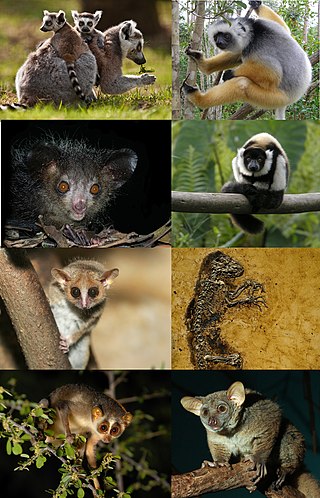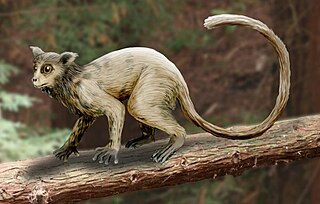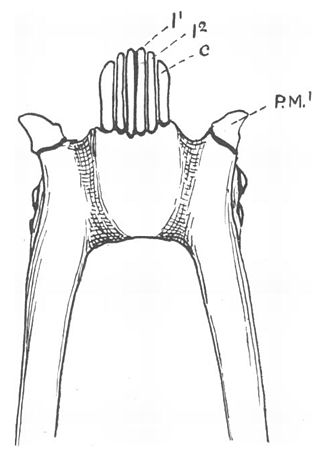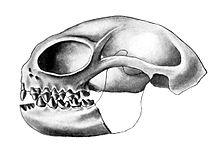
Strepsirrhini or Strepsirhini is a suborder of primates that includes the lemuriform primates, which consist of the lemurs of Madagascar, galagos ("bushbabies") and pottos from Africa, and the lorises from India and southeast Asia. Collectively they are referred to as strepsirrhines. Also belonging to the suborder are the extinct adapiform primates which thrived during the Eocene in Europe, North America, and Asia, but disappeared from most of the Northern Hemisphere as the climate cooled. Adapiforms are sometimes referred to as being "lemur-like", although the diversity of both lemurs and adapiforms does not support this comparison.

Haplorhini, the haplorhines or the "dry-nosed" primates is a suborder of primates containing the tarsiers and the simians, as sister of the Strepsirrhini ("moist-nosed"). The name is sometimes spelled Haplorrhini. The simians include catarrhines, and the platyrrhines.

Adapidae is a family of extinct primates that primarily radiated during the Eocene epoch between about 55 and 34 million years ago.

Tarsiiformes are a group of primates that once ranged across Europe, northern Africa, Asia, and North America, but whose extant species are all found in the islands of Southeast Asia. Tarsiers are the only living members of the infraorder; other members of Tarsiidae include the extinct Tarsius eocaenus from the Eocene, and Tarsius thailandicus from the Miocene. Two extinct genera, Xanthorhysis and Afrotarsius, are considered to be close relatives of the living tarsiers, and are generally classified within Tarsiiformes, with the former grouped within family Tarsiidae, and the latter listed as incertae sedis (undefined). Omomyids are generally considered to be extinct relatives, or even ancestors, of the living tarsiers, and are often classified within Tarsiiformes.

Lemuriformes is the sole extant infraorder of primate that falls under the suborder Strepsirrhini. It includes the lemurs of Madagascar, as well as the galagos and lorisids of Africa and Asia, although a popular alternative taxonomy places the lorisoids in their own infraorder, Lorisiformes.

The simians, anthropoids, or higher primates are an infraorder of primates containing all animals traditionally called monkeys and apes. More precisely, they consist of the parvorders Platyrrhini and Catarrhini, the latter of which consists of the family Cercopithecidae and the superfamily Hominoidea.

Plesiadapis is one of the oldest known primate-like mammal genera which existed about 58–55 million years ago in North America and Europe. Plesiadapis means "near-Adapis", which is a reference to the adapiform primate of the Eocene period, Adapis. Plesiadapis tricuspidens, the type specimen, is named after the three cusps present on its upper incisors.

Adapiformes is a group of early primates. Adapiforms radiated throughout much of the northern continental mass, reaching as far south as northern Africa and tropical Asia. They existed from the Eocene to the Miocene epoch. Some adapiforms resembled living lemurs.

Necrolemur is a small bodied omomyid with body mass estimations ranging from 114 grams to 346 grams. Necrolemur’s teeth feature broad basins and blunt cusps, suggesting their diet consisted of mostly soft fruit, though examination of microwear patterns suggests that populations from lower latitudes also consumed insects and gums. While they do not sport a true tooth comb like modern lemurs, microwear patterns on their lower incisors suggest they engaged in fur grooming behaviors. Like tarsiers, Necrolemur had large, front-facing, close set eyes and were likely nocturnal. Analysis of cranial and postcranial fossils by paleontologists suggest members of the family Omomyidae, including the genus Necrolemur, possessed highly specialized adaptations for leaping.
Shoshonius is an extinct genus of omomyid primate that lived during the Eocene. Specimens identified as Shoshonius have been found exclusively in central Wyoming and the genus currently includes two species, Shoshonius cooperi, described by Granger in 1910, and Shoshonius bowni, described by Honey in 1990.

Teilhardina was an early marmoset-like primate that lived in Europe, North America and Asia during the Early Eocene epoch, about 56-47 million years ago. The paleontologist George Gaylord Simpson is credited with naming it after the French paleontologist, Jesuit and philosopher Teilhard de Chardin.

Notharctinae is an extinct subfamily of primates that were common in North America during the early and middle Eocene. The six genera that make up the group contain species that are among the most primitive of the adapiform group, which is one of the most primitive groups of primates. The evolutionary history of this subfamily has been comparatively well documented and has been used to argue for evolutionary gradualism. Though it is generally accepted that adapiforms gave rise to modern day lemurs and lorises, it is not currently known which branch of Adapiformes these living species are most closely related to. Notharctines became extinct in the middle Eocene, most likely because of a combination of factors including climatic change and competition with other North American primates.

A toothcomb is a dental structure found in some mammals, comprising a group of front teeth arranged in a manner that facilitates grooming, similar to a hair comb. The toothcomb occurs in lemuriform primates, treeshrews, colugos, hyraxes, and some African antelopes. The structures evolved independently in different types of mammals through convergent evolution and varies both in dental composition and structure. In most mammals the comb is formed by a group of teeth with fine spaces between them. The toothcombs in most mammals include incisors only, while in lemuriform primates they include incisors and canine teeth that tilt forward at the front of the lower jaw, followed by a canine-shaped first premolar. The toothcombs of colugos and hyraxes take a different form with the individual incisors being serrated, providing multiple tines per tooth.
Altiatlasius is an extinct genus of mammal, which may have been the oldest known primate, dating to the Late Paleocene from Morocco. The only species, Altiatlasius koulchii, was described in 1990.
Rooneyia viejaensis is a relatively small primate belonging to the extinct monotypic genus Rooneyia. Rooneyia viejaensis is known from the North American Eocene of the Sierra Vieja of West Texas; the species is only known from the type specimen. The lack of additional fossils at this time makes it difficult to hypothesize where and how Rooneyia may have evolved. The minimal wear upon the molar teeth of the specimen has led to the assumption that the type specimen is that of a young adult. Rooneyia does not consistently fall within any one group of fossil or extant primates.

Anaptomorphinae is a pre-historic group of primates known from Eocene fossils in North America and Europe and later periods of Paleocene Asia, and are a sub-family of omomyids. The anaptomorphines is a paraphyletic group consisting of the two tribes Trogolemurini and Anaptomorphini. Anaptomorphine radiation in Wyoming, one of the most detailed records of changes within populations and between species in the fossil record, has provided remarkable evidence of transitional fossils.
Azibius is an extinct genus of fossil primate from the late early or early middle Eocene from the Glib Zegdou Formation in the Gour Lazib area of Algeria. They are thought to be related to the living toothcombed primates, the lemurs and lorisoids, although paleoanthropologists such as Marc Godinot have argued that they may be early simians. Originally described as a type of plesiadapiform, its fragmentary remains have been interpreted as a hyopsodontid, an adapid, and a macroscelidid. Less fragmentary remains discovered between 2003 and 2009 demonstrated a close relationship between Azibius and Algeripithecus, a fossil primate once thought to be the oldest known simian. Descriptions of the talus in 2011 have helped to strengthen support for the strepsirrhine status of Azibius and Algeripithecus, which would indicate that the evolutionary history of lemurs and their kin is rooted in Africa.

Archicebus is a genus of fossil primates that lived in the early Eocene forests of what is now Jingzhou in the Hubei Province in central China, discovered in 2003. The only known species, A. achilles, was a small primate, estimated to weigh about 20–30 grams (0.7–1.1 oz), and is the only known member of the family Archicebidae. When discovered, it was the oldest fossil haplorhine primate skeleton found, appearing to be most closely related to tarsiers and the fossil omomyids, although A. achilles is suggested to have been diurnal, whereas tarsiers are nocturnal. Resembling tarsiers and simians, it was a haplorhine primate, and it also may have resembled the last common ancestor of all haplorhines as well as the last common ancestor of all primates. Its discovery further supports the hypothesis that primates originated in Asia, not in Africa.
Bownomomys was an early marmoset-like primate that lived in North America during the Early Eocene epoch, about 56-50 million years ago.


















